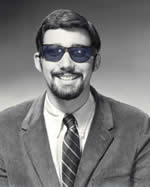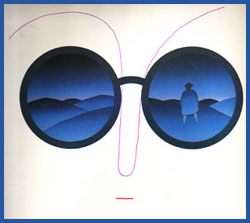|
On each of the
three albums I did for Columbia, I tried to have one
tune which featured my acoustic guitar style, in those
days played on a David Russell Young 6-string
steel-string, set against the backdrop of Don Grolnick's
Fender Rhodes style. On "TIGHTROPE"('77)
this was heard on the tune, "Star Chamber,"
and "Daily Valley" was the acoustic guitar
feature on "THE BLUE MAN"('78).
Here I'm presenting "Daily Village,"
which served this purpose on '79's "ARROWS."
The influence of this tune is actually Martin Denny's
'jungle' classic, "Quiet Village,"
which I used to hear a great deal on the radio in Los
Angeles when I was a kid during the '50s.  I guess
more than anything, what attracted me to that rather
strange little instrumental was the mood suggested by
the harmonies which seemed to float over a bass tumbao
or vamp. I suppose, without actually knowing it, I was
beginning to fall in love with Latin music. By direct
comparison, "Daily Village" is not particularly
complex from a harmonic perspective. I guess
more than anything, what attracted me to that rather
strange little instrumental was the mood suggested by
the harmonies which seemed to float over a bass tumbao
or vamp. I suppose, without actually knowing it, I was
beginning to fall in love with Latin music. By direct
comparison, "Daily Village" is not particularly
complex from a harmonic perspective.
The mood is clearly set
by Grolnick's Rhodes and Will Lee's
interpretation of the bass line(complete with Larry
Graham-isms here and there) on an Ebm7(sus) chord
during [I], and this continues throughout [A].
When I was reviewing this mini-score to present here,
while reading along and listening to the recording,
I realized that I should have written it in cut-time,
because we are feeling the pulse 'in two.'
In other words, you would be tapping your foot on the
half-notes on beats '1' and '3.'
So, I corrected the score to reflect this.
At [A2], where
we finally have our first harmonic release, and the
chord changes to A7(13b5), as with both [A] sections, the
dense voicings reflect a sense of harmony which now
reminds me of the Clare Fischer influence which
became much more profound in later years. One small
arranging device I used to employ selectively was having
Don Grolnick improvise some string pads on the very
old ARP String Ensemble, not a very sophisticated instrument
by today's standards but, in his hands, it still
sounded wonderful. I think, in general, the secret
to making 'synth string pads' work is that, when you
are mixing, you keep them tucked away so that their
appearance is 'felt' more than actually heard. The louder
they are in a mix, the more they reveal their true source.
Finally, at letter [B], after a 5-bar build-up,
we have our true contrast section which features Michael
Brecker playing the Clare Fischer-esque melody on
soprano sax. I recall that I practically had to beg
him to play the soprano sax on this. Because of the
inherent intonation problems, he never liked to play
it, and even went so far as to("accidentally, on
purpose") leave a couple of his sopranos in New
York City taxis, losing them for good!!! Such stories
aside, I had always loved his approach to this instrument,
especially on two obscure and very electric LPs by the
great pianist, Hal Galper: "THE GUERILLA
BAND"('71) and "WILD BIRD"('72).
To this date, I've never seen these recordings
released in the CD format, not even in Japan. But, I
digress, [B] finds us in a C7(b9b5) area, Gb7/C
which is a sonority that can easily have a 'snake
charmer' quality to it and I suppose that this is
in keeping with the rest of the piece.
The extended solo section
from [C] through [C3] reflects the two
main harmonic areas of the tune: Ebm7(sus) and A7(13b5).
Over the Ebm7, I am simply applying an Eb Dorian(Eb,
F, Gb, Ab, Bb, C, Db) approach. However, as there are
E-naturals in the melody at bars 9 and 13 of [A], at
times I also allude to Eb Phrygian, which I just translate
to Db Dorian(Db, Eb, Fb, Gb, Ab, Bb, Cb) because they
contain the same notes. For the A7(13b5) sonority, I
use the E melodic minor scale(E, F#, G, A, B, C#, D#),
though some might choose to call this the A Lydian b7
scale(A, B, C#, D#, E, F# G). Again, they are the same!
In addition to this, I like to apply the B dominant
7th pentatonic(B, C#, D#, F#, A), which captures the
sound of this chordal sonority, but it can also be like
'playing the blues' a whole-step above the root. It
gives things an 'earthy' feel, while still creating
the interesting sounds of the extended harmonies. This
application is discussed in great detail in my forthcoming
book, "PENTATONIC KHANCEPTS."
As always, Don Grolnick's
style of accompaniment is a thing of beauty. He knows
just how one would want to be supported. There was really
no one like him for being sophisticated, sensitive,
soulful and very, very funky!!! As the solo comes to
a close with a long hold on an Emaj7(9#4) chord, we
D.S. back to [B], and again hear Michael's
soprano loosely interpreting the melody with a touch
of 'sass' thrown in for the benefit of all.
One of my favorite moments is at about 4:03 on the CD.
Here Don responds to something Michael plays with a
Richard Tee type of R&B mannerism, played
with simple minor triads in staccato quarter notes going down
chromatically from Ebm-Dm-Dbm. Remember this is fundamentally
against a C7 sound so, in addition to being very
funky, it's actually pretty funny, almost sarcastic
sounding too! [D] is simply a reprise of the
[A] melody. Then we arrive at [E], for
the improvised Fade section, which, like [A2],
is the now the very familiar A7(13b5) sound. As the
fade builds, we spontaneously arrived at a double-time
groove. This groove was so memorable, at least to some
people, that one guy I knew, each time I saw him, used
to remind about that one section, that one moment, as
being his favorite moment on any recording! Hard to
believe! After about bar 9 of the fade, as the soloist,
I make any number of double-time inferences and somehow
from this, just at the tail-end, once I've switched
to chords, Will, Don and Steve follow suit and off we
go.
Though I've mentioned
this elsewhere at the site, the DISCOGRAPHY perhaps,
I was lucky to have been given a 2nd chance to produce
myself because the sales of "THE BLUE MAN"
were about 1/2 of what "TIGHTROPE"
had achieved, and in this business, that's hardly
viewed as 'progress' by an A&R executive.
I remain very grateful to both Bruce Lundvall
and Jim Fishel for staying with me through these
three recordings. Anyway, that said, I was told that
I had to have a co-producer, and was lucky enough to
get my dear friend, the brilliant engineer, Elliot
Scheiner to work with me. Many of you would be familiar
with Elliot's Grammy Award winning work from his
recordings with Steely Dan and the Eagles.
Now as for the title of
this tune, and a couple of others, people have often
asked me, "What does this 'Daily' stuff
mean in your song titles?" Well, the truth is,
it really doesn't mean anything specific, and certainly
nothing too deep! Sometime between '77-'78,
I went to an exhibit in New York City of some of the
watercolors painted by Jean-Michel Folon, whose
art has graced some 13 LP/CD covers of mine. I have
often searched for song titles derived from the titles
of his paintings, which usually have already been translated
into English from his native French. Anyway, at this
exhibition, I saw a painting which was titled "Daily
Bulls," and it looked like two columns of Sphinx
heads and bodies. I just couldn't make the connection
between the title and what I saw. However, I wrote down
this title, as it was interesting, in a little notebook
and it later became the title for one of the Latin-influenced
tunes on "THE BLUE MAN." I also simply
'attached' the word 'Daily' in front
of another tune title, and that became "Daily Valley."
Neither title really 'means' anything, and
certainly nothing 'deep!' So here, as this piece was
influenced by "Quiet Village," it simply became
"Daily Village." And there you have it, simple
as that! I have
often searched for song titles derived from the titles
of his paintings, which usually have already been translated
into English from his native French. Anyway, at this
exhibition, I saw a painting which was titled "Daily
Bulls," and it looked like two columns of Sphinx
heads and bodies. I just couldn't make the connection
between the title and what I saw. However, I wrote down
this title, as it was interesting, in a little notebook
and it later became the title for one of the Latin-influenced
tunes on "THE BLUE MAN." I also simply
'attached' the word 'Daily' in front
of another tune title, and that became "Daily Valley."
Neither title really 'means' anything, and
certainly nothing 'deep!' So here, as this piece was
influenced by "Quiet Village," it simply became
"Daily Village." And there you have it, simple
as that!
With the posting of this
tune at KHAN'S KORNER 2, we have now presented one piece
from each my first recordings as a leader. In the coming
months, more and more compositions will be featured,
and we are hoping that you are all enjoying having access
to these lead sheets and mini-scores. It's been wonderful
to see the response, and then read the feedback from
all over the world. Thanks so much to you all!!!
[Photo:
Steve, ca. '67 @ U.C.L.A., as a beatnik, "Maynard G. Krebs"(from "DOBIE
GILLIS") wannabee, but really trying to look like Charles Lloyd on
the cover of his "DREAM WEAVER" LP.
Folon's famous "Glasses" seriegraph with a portion of the 'doodles' he made in my book!]
|

